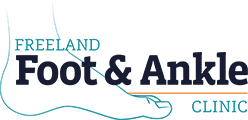If you work in the trades, chances are you have, at some point, experienced foot or ankle pain. Whether you work in HVAC, construction, sanitation, welding, manufacturing, or anything in between, your career comes with certain risks the rest of us don't have to worry about.
In order to take care of your feet at work, you should follow workplace safety guidelines, wear steel or composite-toe boots, stretch regularly, and use shoe inserts for extra support.
Keeping your feet happy, healthy, and safe when you work in a sometimes-dangerous environment can be challenging, so we've broken down our top tips for doing just that.
![work boots and yellow construction helmet on a wooden platform background]() Workplace Safety for Your Feet
Workplace Safety for Your Feet
Regardless of your line of work, you likely encounter numerous risks throughout the day. Potential hazards like falling objects, electrical hazards, slippery surfaces, and hot, corrosive, or poisonous substances can put your feet, ankles, and toes at risk. Your employer should have their own set of rules and guidelines to help keep you and your feet safe on the job, and it's important to follow these rules to the best of your ability. While those regulations may change from trade to trade, here's a basic list to get you started:
- Always wear proper footwear. Whether your workplace requires safety-toes, steel-toes, metatarsal guards, or toe guards, invest in a good pair of boots or shoes.
- Minimize your risk for falls. Falling is never a good thing, and it can be especially dangerous when you work in a hazardous environment. Slip-resistant footwear will help you avoid falling, and studded treads or treaded overshoes can provide more traction if you work outside in the rain, ice, and snow.
- Take care of your feet before, during, and after your shift. Stretching your feet in the morning and evening will prevent injury, pain, and discomfort. If you already experience heel pain, stretching, along with proper footwear, will help to alleviate the pain. Keep reading to learn the best way to stretch your feet to get rid of heel pain.
Stretches to Get Rid of Heel Pain at Home
When you work on your feet all day, which for some can be up to twelve hours, it's important to take care of your feet when you get home. I recommend stretching every morning if you can. The stretches below are quick, easy, and accesible. You can even do these stretches on your lunch break!
![towel stretch]() The Towel Stretch. To help stretch out the plantar fascia, the large tendon running along the bottom of your foot and the most common cause of heel pain, all you need is a towel. Sitting on the floor with your legs stretched out in front of you and your toes pointed to the sky, hold one end of the towel in each hand and loop it around the ball of your foot. Gently pull back with the towel so that your toes start pointing slightly back. You should feel a stretch in your arch. Hold this for 20-30 seconds on each foot.
The Towel Stretch. To help stretch out the plantar fascia, the large tendon running along the bottom of your foot and the most common cause of heel pain, all you need is a towel. Sitting on the floor with your legs stretched out in front of you and your toes pointed to the sky, hold one end of the towel in each hand and loop it around the ball of your foot. Gently pull back with the towel so that your toes start pointing slightly back. You should feel a stretch in your arch. Hold this for 20-30 seconds on each foot. ![standing calf stretch]() The Standing Calf Stretch. This stretch works your calves, which will help alleviate and prevent lower-limb discomfort. Face a wall and place your palms flat on it. Keep your toes as close to the wall as you can and step back with your left foot, planting your left foot and heel firmly to the floor. Press your hips forward, bending your right leg slightly and feeling that wonderful stretch in your left calf. Hold for 20-30 seconds and then repeat on the other side.
The Standing Calf Stretch. This stretch works your calves, which will help alleviate and prevent lower-limb discomfort. Face a wall and place your palms flat on it. Keep your toes as close to the wall as you can and step back with your left foot, planting your left foot and heel firmly to the floor. Press your hips forward, bending your right leg slightly and feeling that wonderful stretch in your left calf. Hold for 20-30 seconds and then repeat on the other side. ![stair stretch]() The Stair (or Curb) Stretch. Stand with the balls of both feet on the edge of a stair or curb with at least one hand holding onto something sturdy for balance. Keeping your legs straight, allow both heels to lower slowly to hang off the edge of the stair or curb. You'll feel a stretch in your ankles and calves. Hold for 15-30 seconds to alleviate Achilles tendon pain.
The Stair (or Curb) Stretch. Stand with the balls of both feet on the edge of a stair or curb with at least one hand holding onto something sturdy for balance. Keeping your legs straight, allow both heels to lower slowly to hang off the edge of the stair or curb. You'll feel a stretch in your ankles and calves. Hold for 15-30 seconds to alleviate Achilles tendon pain.
In addition to these stretches, using a Theraband Foot Roller, which can be frozen, will help to alleviate pain, discomfort, and inflammation.
Preventing Foot Pain at Work
If you asked our front desk receptionist the most common questions patients ask on the phone, one would stick out above the rest:
How do I keep my feet from hurting when I have to stand for 8, 10, 12 hours a day?
Unfortunately, there's no one-size-fits-all solution to heel pain, but relief is possible. The best place to start is by taking a look at your footwear as well as what is hiding inside your footwear. As a baseline, be sure that you are wearing high-quality, supportive shoes or boots. Wearing a pair of boots that fits properly is also crucial and will help avoid ingrown toenails caused by ill-fitting footwear. For guidance on picking out a pair, check out our article highlighting the qualities of the best work boots for comfort and safety. Once you're wearing a great pair of work boots, whether they are steel toe, composite toe, waterproof, or soft toe, we can start talking about removable shoe inserts.
![pure stride]() Should You Wear Over-the-Counter or Custom Foot Orthotics to Work?
Should You Wear Over-the-Counter or Custom Foot Orthotics to Work?
Before deciding which type of shoe insert is right for you, here's the low-down on the two most common varieties:
- Custom Orthotics are uniquely-crafted insoles that are made with your specific anatomy, conditions, and gait in mind. They are typically billed through insurance and are very durable.
- Over-the-Counter Orthotics are prefabricated, but can offer support to those with less severe foot problems. They are not covered by insurance and cost around $40, though they may be acceptable purchases through your HSA/FSA.
Now that you know the two different types of orthotics, you can weigh your options. Your foot specialist, physical therapist, occupational therapist, or chiropractor can also help you decide. Generally, custom orthotics are preferred for those who spend most of their day on the move because they prevent heel pain in the first place and can stop it once it's started.
Don't Wait to Treat Your Foot or Ankle Pain
Waiting to seek treatment for pain of any kind is not ideal. In the time spent waiting for the problem to disappear, you could actually make the issue worse or cause more extensive injuries. Not only that, but dealing with pain when you work in volatile, hazardous environments like construction sites or factories can cause distraction and even lead to you making costly, dangerous mistakes. Don't wait another minute, because you deserve a pain-free life, and a pain-free life is possible.

 Workplace Safety for Your Feet
Workplace Safety for Your Feet The Towel Stretch. To help stretch out the plantar fascia, the large tendon running along the bottom of your foot and the most common cause of heel pain, all you need is a towel. Sitting on the floor with your legs stretched out in front of you and your toes pointed to the sky, hold one end of the towel in each hand and loop it around the ball of your foot. Gently pull back with the towel so that your toes start pointing slightly back. You should feel a stretch in your arch. Hold this for 20-30 seconds on each foot.
The Towel Stretch. To help stretch out the plantar fascia, the large tendon running along the bottom of your foot and the most common cause of heel pain, all you need is a towel. Sitting on the floor with your legs stretched out in front of you and your toes pointed to the sky, hold one end of the towel in each hand and loop it around the ball of your foot. Gently pull back with the towel so that your toes start pointing slightly back. You should feel a stretch in your arch. Hold this for 20-30 seconds on each foot.  The Standing Calf Stretch. This stretch works your calves, which will help alleviate and prevent lower-limb discomfort. Face a wall and place your palms flat on it. Keep your toes as close to the wall as you can and step back with your left foot, planting your left foot and heel firmly to the floor. Press your hips forward, bending your right leg slightly and feeling that wonderful stretch in your left calf. Hold for 20-30 seconds and then repeat on the other side.
The Standing Calf Stretch. This stretch works your calves, which will help alleviate and prevent lower-limb discomfort. Face a wall and place your palms flat on it. Keep your toes as close to the wall as you can and step back with your left foot, planting your left foot and heel firmly to the floor. Press your hips forward, bending your right leg slightly and feeling that wonderful stretch in your left calf. Hold for 20-30 seconds and then repeat on the other side.  The Stair (or Curb) Stretch. Stand with the balls of both feet on the edge of a stair or curb with at least one hand holding onto something sturdy for balance. Keeping your legs straight, allow both heels to lower slowly to hang off the edge of the stair or curb. You'll feel a stretch in your ankles and calves. Hold for 15-30 seconds to alleviate Achilles tendon pain.
The Stair (or Curb) Stretch. Stand with the balls of both feet on the edge of a stair or curb with at least one hand holding onto something sturdy for balance. Keeping your legs straight, allow both heels to lower slowly to hang off the edge of the stair or curb. You'll feel a stretch in your ankles and calves. Hold for 15-30 seconds to alleviate Achilles tendon pain. Should You Wear Over-the-Counter or Custom Foot Orthotics to Work?
Should You Wear Over-the-Counter or Custom Foot Orthotics to Work?